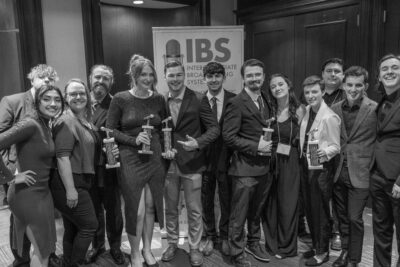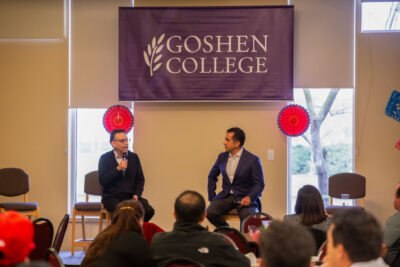For the first time in its history, the Goshen College theater department will be producing a show with a lead who speaks only in sign language.
Tuc, a young man who is deaf and mute, is one of three main characters in the Depression-era play “Mother Hicks,” written by Susan Zeder. Tuc will be portrayed by Kailey Rice, a freshman American Sign Language (ASL) Interpreting major.
The cast will be consulting with Nourie Marrakchi, an ASL teacher at Elkhart Memorial High School Marrakchi has a background in professional theater at The Rocky Mountain Deaf Theater in Aurora, Colorado.
Marrakchi said he “really enjoyed” his previous experience in theater and is “very excited to be back and involved, to be learning from [the GC theater department] and providing support.”
Although Marrakchi can read lips, he was interviewed with the help of a translator.
Marrakchi considered taking the role of Tuc himself. Ultimately, however, schedule conflicts made him opt for a behind-the-scenes role guiding Rice in her attempt to portray a deaf man.
Students and staff in GC’s ASL program will be also be working alongside the theater team throughout the process- translating for Marrakchi during rehearsals, assisting cast members with sign language and providing insight on how to best portray a member of the often underrepresented deaf community.
“We need [the ASL program] in order for us to do this with integrity,” said Doug Caskey, chair of the Goshen College theater program and director of the show.
Amanda Flickinger, one of GC’s ASL professors, was involved in the production from the beginning. Flickinger was also interviewed by means of a translator.
Since Caskey first approached her with the idea of producing “Mother Hicks,” Flickinger has said she “really loved the play.” She was insistent, however, that Tuc be played by a deaf actor or a highly skilled signer, “out of respect to the deaf community.”
Rice fit the bill. After taking all the ASL courses her Dallas, Texas high school had to offer, she enrolled in classes at Collin College, in McKinny, Texas. She was able to start her freshman year at Goshen in ASL 5 classes.
“I started signing because it was something I loved to do for fun,” Rice said. “It is so expressive and visual. I am a very visual person, so much of sign language feels natural for me.”
Rice isn’t the only member of the cast to have spent time interacting with the Deaf community. Jessica Croy, a first-year theater and history major who also has a lead role in the show, grew up with a deaf mother. Her situation, however, is slightly different; Jessica’s mother, Gloria, has never learned ASL.
“Her parents didn’t want her to go to a deaf school because she would have had to live away from home,” said Jessica. She explained that her mom went to speech therapy as a child, and gets by with lip reading and the help of hearing aids.
“Ever since I was little, I’ve wanted to learn sign language so I could teach some to my mom,” said Jessica. “As she gets older, it will get harder for her to communicate in the way she does now.” Jessica is currently in enrolled in ASL 1 at Goshen.
The sign language used in the show will not be strictly ASL. The script calls for some use of “home signs”- unofficial gestures invented by families or close groups of friends to stand in for words that are either unknown to them in ASL, or that don’t have an official sign. Home signs used in the show will be created with the help of Marrakchi.
“I’ll have to remind myself that [in the 1930’s] home signing was much more popular,” said Marrakchi. “Some of those signs will have morphed into real ASL; I’ll have to pay attention to the time period, in terms of which signs were used then and which weren’t.”
If an actor uses only a mixture of ASL and home signs to communicate, how will they be understood by a hearing audience who (mostly) cannot understand them? The answer comes in a modern revamp of an ancient theatrical technique- the Greek Chorus. As Tuc signs, a group of other characters will interpret for him, letting the audience hear and understand everything that he says.
“It’s kind of cool the way [the playwright] wrote it; a hearing audience… needs interpretation, not the other way around,” Caskey said. “I’m thrilled to be turning this completely around to see what that will be like.”
It is important to note that while the presence of a leading deaf character makes it unique, that aspect of the show isn’t necessarily what the audience should be paying the most attention to. “This isn’t a play about deaf people,” Caskey said. “It just so happens that there is one character who is deaf.”
“Mother Hicks” was named “the most significant (children’s) play of the 1980’s” by the Denver Post for what it teaches about “inclusion, identity and redefining family.”
According to Caskey, those very qualities were important factors in the decision to produce this play. He referenced several recent and ongoing issues, including those surrounding immigration and the recent rallies in Charlottesville.
Caskey expressed hope that, beyond simply providing a couple hours of entertainment, this show can be educational as an example of crossing cultural boundaries and in doing so, learning about our own culture.
“[In the show] conflicts arise because of our fear of people who are different from us. Theater is one way to hold the mirror up to ourselves,” Caskey said.
Caskey also mentioned that the Goshen College ASL program has recently been trying to enhance access to the arts for the Deaf community. Among other things, they have started providing ASL interpreting for The Round Barn Theatre in Nappanee. “Mother Hicks” seemed to be a timely way to link this idea back home to campus. Not only does this reach the student body, but also the larger Goshen community.
“Mother Hicks” will be playing Nov. 10-12 and 18-19 in Umble Center.

